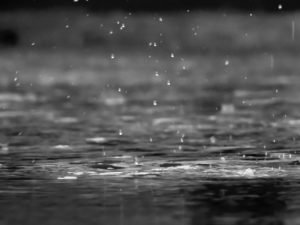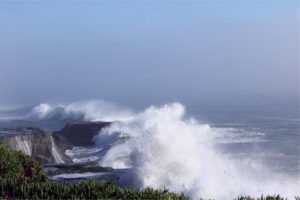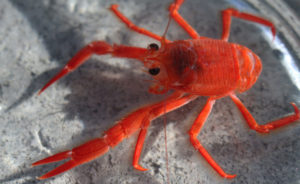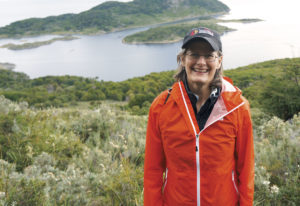Above is an image, generated on Monday, of current sea surface temperature anomalies — that is, the difference between the current temperature and the average temperature between 1961-1990. It shows the hottest temperatures in the North Pacific Ocean since we started keeping records. That’s following July, which was the hottest month ever recorded on Earth. Just about everything about this picture is historically unprecedented.
The ocean, says University of Washington Research Meteorologist Nicholas Bond, is prepartying. We’ve seen widespread above-average temperatures in the North Pacific before (although never like anything this high), but only following El Niños, like in 1958 and 1998. Those cases, Bond says, were “more of a hangover from El Niño.” Now, he says, with a historically strong El Niño just beginning, “we’re going into the party with a snootful.”
Here’s a more stylized look at temperature anomalies in the eastern Pacific Ocean this July:

In this one, red represents degrees above average between 1981-2001. You see the classic signature of El Niño, that tres haute red sash around the globe. You also see, again, what no one has ever seen before: the heat is everywhere. It’s hot at the Equator, it’s hot inshore, and it looks like there’s lava spilling off of California and southeast Alaska.
The pattern has given rise, recently, to concern. The unprecedented warm water in the North Pacific has come to be known as “The Blob,” and it’s been sitting there for two years. You might have seen headlines about “El Niño Vs. The Blob” — this is the question they’re worrying about: If one of the dominant features of the last two years of heat and drought is The Blob, and The Blob is still there when the El Niño starts, what if The Blob and the El Niño get into a tug of war over the jet stream and The Blob wins and it doesn’t rain?
Short answer: don’t worry about it. It’s a misplaced competition, like worrying about the threat sharks pose to cows. Even if it wanted to, The Blob is simply not capable of doing anything to El Niño.
“There’s just no evidence that this is a feature that will be important this winter,” says Stanford graduate student climate scientist Daniel Swain, who runs the California weather blog.
“The Blob” is a label first applied by Bond, who used it while on air on his weekly weather show for Seattle’s NPR affiliate (he says he noticed that the host immediately perked right up). He originally coined it, he writes in a 2015 article in the journal Geophysical Research Letters, to describe an extremely unusually warm region of water in the Northern Pacific south of Alaska, and west of Oregon and Washington. (Technically, between 40°-50°N and 150°-135°W.) But like any good blob, this one quickly escaped into the wider world, and now it is hard to pin down an exact definition — especially since the hot water region has morphed and stretched and evolved, into this summer’s wide-ranging warmth that touches the continental shelf off the Pacific Northwest and spreads down all the way to Baja.
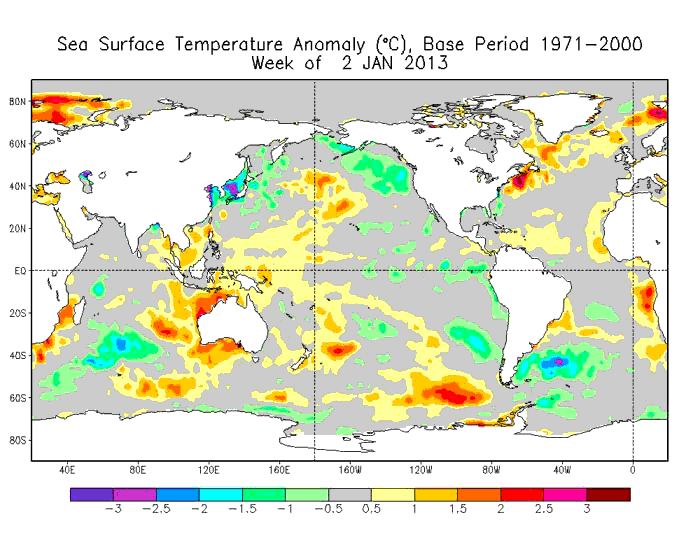
For marine life, warmer water has meant a changed ecosystem: whales inshore, birds failing to nest, sunfish and thresher sharks and skipjack tuna off the coast of Alaska, seals and sea lions ranging farther in search of fish and increasingly needing rescue. By August the Marine Mammal Center in Sausalito had already rescued 1,500 sea lions, double its annual average. Algal blooms have poisoned sea life across the Pacific Northwest, from otters to pinnipeds, and the effects of the blooms are still being felt.
Remember, they are an exotic species in the Western United States, and are rapidly increasing their geographic range and range of habitats. Are they outcompeting or excluding native species in the process? How would we know? We have done almost nothing to monitor changes in the assemblage of mushroom species in areas before and and after the incursion of death caps.
Further Reading
Pringle et al, “The ectomycorrhizal fungus Amanita phalloides was introduced and is expanding its range on the west coast of North America,” Molecular Biology 2009
Lockhart et al, “Simultaneous emergence of multidrug-resistant Candida auris on 3 continents confirmed by whole-genome sequencing and epidemiological analyses,” Clinical Infectious Diseases 2017
Battalani et al, “Aflatoxin B1 contamination in maize in Europe increases due to climate change,” Scientific Reports 2016
El Niño: Beyond the Hype
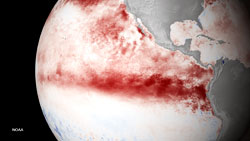
Bay Nature goes beyond the headlines to explore what the strongest El Niño in recorded history might mean — or not — for Northern California. We’ll post new articles here every Tuesday through the fall.
This series has been funded by donations from Bay Nature readers. Please help us by sharing our work, or donate today to support our mission to explore the natural world of the Bay Area.
On land, a warm ocean nearby has meant warmer air temperatures. San Francisco is usually cooled by fog blowing off an ocean that’s in the mid-50s in the summer; this year it’s blowing off an ocean in the mid-60s. “If you look at a place like San Francisco over the last year year and a half, almost every day its mean temperature is above normal,” Bond says. “It’s remarkable how particularly warm it’s been.”
The Blob, in other words, makes life a little less pleasant for most coastal life. It has significant local effects. What it almost certainly will not do is mess up any El Niño-related storms this winter, because The Blob can’t influence atmospheric weather patterns. It can’t change the storm track; it can’t create its own winds. Perhaps the confusion arises, says NOAA atmospheric scientist Michelle L’Heureux, because in the tropics the ocean can influence the atmosphere — the two work in concert to create big-picture weather patterns. But outside the tropics, and with the exception of a few well-known areas like the Gulf Stream, the relationship only goes one way. “There’s a dynamics 101 issue here,” L’Heureux says. “In the extratropics, atmospheric circulation affects sea surface temperatures, but it doesn’t work in the reverse.”
The Blob is a symptom of an unusual atmospheric pattern, not a cause. An annoying symptom if you don’t like a hot humid house in San Francisco, but one that won’t dramatically outlive the far more villainous culprit in California’s drought: “The Ridge.”
“Even if we’re underestimating the role of this Blob, most model simulations say it’s going away this winter anyway,” Swain says. “Not surprising; all the indications at this point are that The Blob didn’t exist independently of the ridge in the first place. And the things that did lead to the ridge in the first place aren’t really there anymore.”
Remember, they are an exotic species in the Western United States, and are rapidly increasing their geographic range and range of habitats. Are they outcompeting or excluding native species in the process? How would we know? We have done almost nothing to monitor changes in the assemblage of mushroom species in areas before and and after the incursion of death caps.
Further Reading
Pringle et al, “The ectomycorrhizal fungus Amanita phalloides was introduced and is expanding its range on the west coast of North America,” Molecular Biology 2009
Lockhart et al, “Simultaneous emergence of multidrug-resistant Candida auris on 3 continents confirmed by whole-genome sequencing and epidemiological analyses,” Clinical Infectious Diseases 2017
Battalani et al, “Aflatoxin B1 contamination in maize in Europe increases due to climate change,” Scientific Reports 2016
Reading List
Each post in Bay Nature’s El Niño series features a reading list with links to more technical or scientific explanations.
- Geophysical Research Letters: Pacific Sea Surface Temperature and The Winter of 2014, by Dennis Hartmann
- Geophysical Research Letters: Causes and Impacts of the 2014 Warm Anomaly in the NE Pacific, by Nicholas Bond, Meghan F. Cronin, Howard Freeland, and Nathan Mantua
- Climate.gov El Nino Blog: The Tropics as a Prime Suspect Behind the Warm-Cold Split Over North America During Recent Winters, by Dennis Hartmann
- Climate.gov El Nino Blog: August 2015 El Nino Update: Supercalifragilisticexpealidocious, by Emily Becker
- The California Weather Blog, by Daniel Swain
“The Ridiculously Resilient Ridge,” as Swain has labeled it, is a region of unusually persistent and record-high pressure over that same part of the North Pacific. It too shifts and moves and sometimes briefly even disappears. But essentially for the last two winters the ridge has acted like a giant bubble dome over the ocean, deflecting the storm track northward away from the West Coast, and into the Arctic where it picked up a bunch of freezing air to dump ice and snow down America’s backside. (The East Coast.)
With the ridge in place, the West Coast’s typical northwest winds — which stir up the ocean and draw colder water from beneath the surface in the process known as upwelling — slackened, allowing the water to heat up. It’s the ridge that caused The Blob, and blocked the storm track. It’s the ridge, if it returned, that might block El Niño-inspired rain on the West Coast. In theory, The Ridge would be a worthy opponent to an El Niño. So what caused the ridge — and is that cause still out there? “In the hypothetical situation where there were to be a persistent ridge in the same region where there has been one for the last few winters, and at the same time there was a strong El Niño — in that hypothetical it’s not entirely clear what would happen,” Swain says. “But that’s hypothetical, because it assumes you have no knowledge of what causes the ridge and whether it’s likely to recur.”
The ridge, University of Washington atmospheric scientist Dennis Hartmann writes in the journal Geophysical Research Letters, has been driven mainly by a configuration in the tropical western Pacific Ocean called the North Pacific Mode, characterized by a band of warm water between the North American West Coast and Micronesia, a finger of colder water stretching from Japan and the Philippines into the Pacific north of Hawaii, and a large swath of cold water off the West Coast of South America. (The last time the NPM was this strong, Hartmann writes, was just before the 1997-1998 El Niño.)
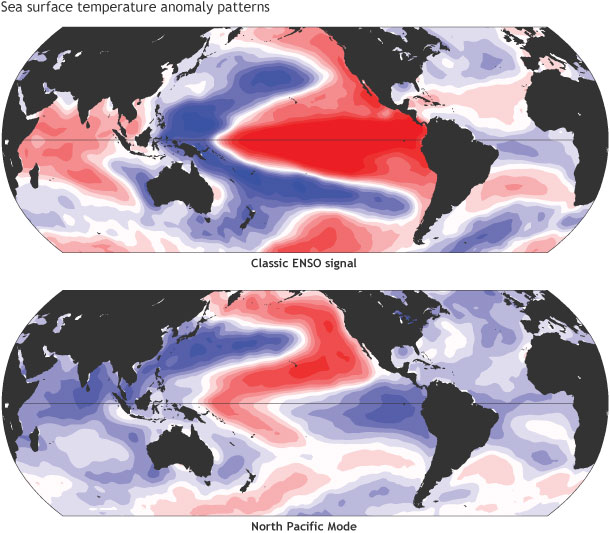
If you model the atmosphere based on that pattern, Hartmann writes, you see a region of persistent high pressure form over the North Pacific, aka, The Ridge. Observation over the past few decades backs up the models. Recently, of course, the ridge that’s actually appeared has been something stronger than what the models predict, indicating there are other elements in play. (This is, in part, what Swain studies for his dissertation: the influence of factors like Arctic sea ice and greenhouse gases that contributed to the observed strength — the “ridiculous” resilience of the ridge.)
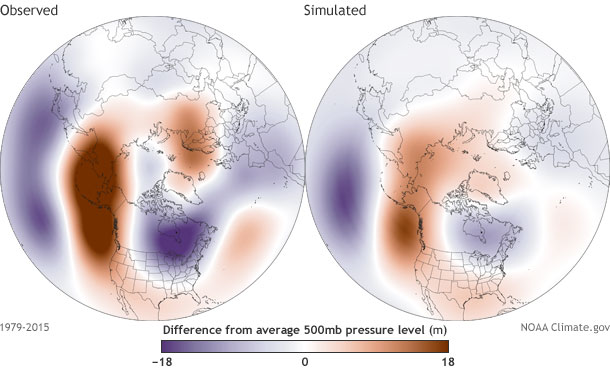
This is the important point: the NPM, which likely caused the ridge, which certainly caused our drastic two-year precipitation deficit — it’s gone. El Niño has disrupted it. There’s therefore no reason to believe the ridge will re-form, no reason to think the storm track will be deflected, and no reason to think The Blob will persist. “The climate models used for seasonal weather prediction are pretty emphatic about this,” Bond says. “We don’t expect a big ridge in the Northeastern Pacific this winter.”
With the ridge gone, the storm track should return, stirring up the water and causing the warm surface water to slowly mix out with the cold water underneath. It will take a while, because the ocean doesn’t cool down as quickly as the air does. “Even if you get a jet stream pattern perfectly placed to cool the ocean down, it’s not going to change overnight,” L’Heureux says. “There’s enough inertia there that I suspect there will be warmth off the coast this coming winter.”
Perhaps the best question is: when will the ocean be cold again? No one can quite say. Our ability to forecast beyond a year or so is essentially zero. Cooling La Niña events often follow El Niños, but there’s no real indication that’s necessarily going to happen, Bond says. “While I’m highly confident it’s going to be warm along the coast into winter of 2016, probably into the spring, after that all bets are off,” he says. “A year from now, it may just be kind of memory.”


